Squadron battleship "Sisoy the Great". From birth to Tsushima
"Great Sisoy." Among Russian armadillos fleet this name is not used often. Meanwhile, the design and construction of the ship fell on the period when the main directions of the development of the domestic fleet were determined, and its service ended on one of the most tragic days - May 15, 1905, in the Tsushima battle.
Starting a story about this battleship is from August 1881, when a Special Meeting was held in St. Petersburg under the leadership of Grand Duke Alexei Alexandrovich, whose task was to determine the foundations of Russia's naval policy and develop a twenty-year shipbuilding program. The result of his activity was a program whereby for the Russian fleet in the Baltic the main task was to ensure superiority over the fleets of other coastal states. Separately stipulated the condition that the domestic fleet should at least not yield to the German, and it is desirable to have an advantage over it in the open sea. To achieve this goal, it was planned to build 16 battleships for the Baltic Sea. Taking into account the tactical and technical elements of their likely opponents, the displacement of the planned ships was limited to 8400 t, and the armament to a pair of 305-mm guns.
By the middle of 1888, these requirements changed in the direction of increasing combat power, and the fourth battleship of the program, Navarin, had already four 9476-mm guns deployed in two armor towers with a design displacement of 305 t. The Maritime Technical Committee (MTC) did not, however, agree on both the size of future ships, and their armament, the type of turret installations and booking. Therefore, the project of the fifth battleship was the development of "Emperor Alexander II", and not much stronger "Navarin." With a length between perpendiculars in 101 m, maximum width 20,42 m and draft 6,4 m, the displacement of the projected battleship was 8500 t. Two steam engines with a total power 7300 hp, according to calculations, should have provided the ship with a speed of at least 16 knots and 600 - ton of coal stock - cruising range economical course 3047 miles.
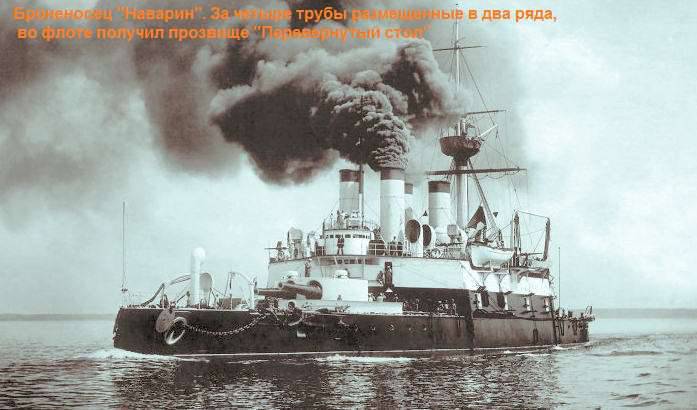
The project assumed a sufficiently powerful booking: the board - 406 mm (to the nasal tip the thickness decreased to 356 mm, to the stern - to 305 mm), the beam - 216-241 mm, barbety - 305 mm, cover for barbet installations - 64 mm, casemates - 127 mm mm, karapasnaya deck - 51-64 mm, conning tower - 152 mm.
The armament of the new battleship was supposed to consist of three 305-mm guns placed in two barbet installations (two-gun on the nose, one-gun on the stern), four 152 mm caliber guns, four 120-mm guns on the upper deck and ten small-caliber Gochkis guns.
In early September, 1890, the ITC sent this project to a number of well-known admirals and received in response a variety of opinions. Vice-Admiral A.A. Peshchurov and Rear Admiral S.O. Makarov found it necessary to increase the main-caliber artillery by one 305-mm gun by installing it in a barbet aft installation. In turn, Vice-Admiral P. P. Pilkin, on the contrary, suggested reworking the project according to the type of ramming battleships and completely removing the stern barbet, while reinforcing the armament with a pair of 229-mm guns in the casemate. V.P. Verkhovsky, S.O. Makarov and P.P. Pilkin considered it necessary to increase the power of steam engines and the speed of the ship by reducing the weight of armor, and О.К. Kremer, on the contrary, considered booking a casemate insufficient. Vice-Admiral N. V. Kopytov proposed to completely abandon the construction of the battleship and build a cruiser. Vice Admirals N.I. Kaznakov, V.I. Popov, A.I. Kupreyanov, Rear Admirals PP Tyrtov and S.S. Valitsky agreed with the project, not considering it necessary to engage in any discussions.
Having received all these conflicting reviews, MTK reworked the project at the end of 1890. January 29 1891-second Marine Department Manager, Admiral N.M. Chikhachev as a whole approved it, after which they began to draw up the necessary drawings of the “battleship in 8880 tons”, which were completed by March 6 of the same year with the approval of the specification. The ship, initially referred to in the ITC documents as “Gangut” No. 2, had a steel hull with a maximum length of 106,98 m, width of 20,7 m, with 94 frames and a double bottom along the 20 to 76 frame. Along the entire length of the engine and boiler rooms, a longitudinal diametrical bulkhead was provided from the second bottom to the armored deck. The ship hull had continuous bottom stringers, zygomatic keels of length 35 m, forged akhter- and stem. The latter was strengthened for use as a ram.
The armor protection was made of ironclad plates. The side belt had a length of 69,2 m, and a width of 2,18 m (1,22 and below the waterline). The machine and boiler rooms of the battleship (length 42,7) were covered with slabs up to 406 mm thick, although the thickness decreased to the lower edge to 203 mm, then to the bow and stern of the ship to 305 mm (at the lower edge - 152 mm). The length of the casemate on the residential deck was 46,3 m. The width of the 127-mm armor plates covering it was 2,3 m, and in the casemate, on the battery deck with the same thickness, 1,92 and 2,24 m, respectively. The lining under the armor was made of larch bars 229 thick (under side armor) and 152 mm (for casemate armor). The 305-mm fore and aft barbettes were installed on the battery deck and exceeded the upper deck on the 0,69 m. The vertical larch bars of the barbet lining bar were 152 mm thick. On top of the main-caliber guns were covered with dome-shaped covers 63,5 mm thick. Nose traverse had a booking thickness of 229 mm, stern-203 mm, conning tower - 229 mm, decks - 64-76 mm.
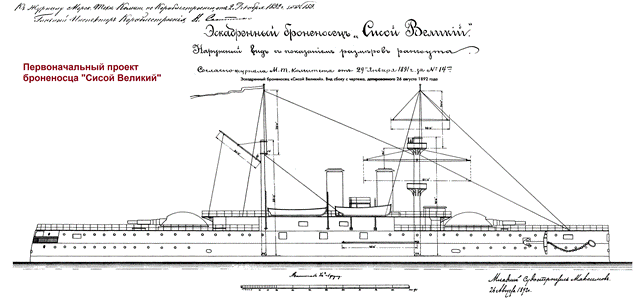
The main power plant included 8 fire tube boilers (4 double-sided, 4 single-sided) with a total heating surface of 2202 square meters. m, providing the ferry two main machines with a total capacity of 8500 HP The highest speed was planned in 16 knots, and the estimated cruising range was 4440 miles with 10 knots. The drainage system consisted of a 4 steam centrifugal pump with a feed rate of 750 t / h, a steam piston pump (125 t / h); two ejectors and a fire pump.
The armament was planned from four 305-mm guns placed in pairs in barbet installations, six 152-mm casemate guns, twelve 47-mm single-barreled and four 37-mm multi-guns of Hotchkas. In addition, it was planned to install six surface torpedo tubes, two 64-mm Baranovsky paratroopers. In the mine cellars it was possible to take up to 50 spheroconical mines. On the battleship it was planned to install two masts 16,7 m high: one steel with two combat mars, the second wooden “for signals”. The crew was to consist of 500 lower ranks and an 32 officer.
Trying to accelerate the start of ship construction, the General Directorate of Shipbuilding and Supply (GUKiS), even before the development of the 7 drawings was completed in January of 1891, made an attempt to place an order for the manufacture of keel and bottom sheets at the Izhora state plant. The latter, loaded with urgent orders, refused flatly, and GUKiS had to send bids for the supply of 3200 tons of steel to six plants, of which only four (Putilovsky Zavod Society, Aleksandrovsky Steel Foundry, Bryansk Rail Rolling Plant and South Russian Dneprovsk Metallurgical Society) gave a positive response. As a result, the conditions of the Aleksandrovsky Plant were the most acceptable, however, GUKiS, transferring to it the order 4 of June, for some completely incomprehensible reason, slowed down the conclusion of the contract until mid-February 1892. In the future, this delay created many difficulties in relations with the plant (supply disruptions, of which there were many). The Board of the plant at any opportunity referred to the absence of the concluded contract and not set deadlines.
25 July The 1891 of the year in the wooden shed of the New Admiralty set about building a new battleship. And December 21, he was enrolled in the Russian fleet under the name "Sisoy the Great." The solemn laying of the battleship took place on May 7 next year, in the presence of the emperor and heir, Tsarevich Nicholas.
The builder of "Sisoi the Great" was appointed senior naval engineer V.V. Maximov. It is worth noting, however, that the general management of the ship’s construction was entrusted to the position of Rear Admiral V.P., commander of the St. Petersburg port, in force at that time. Verkhovsky, who immediately developed a stormy activity. However, his attempts to accelerate the construction of the battleship often rested on the irresponsibility of GUKiS. Being engaged in material provision of construction, GUKiS in some cases did not take care of the timely conclusion of the necessary contracts, for example, on the steering frame, for- and top-steers, propeller shaft brackets. An attempt to place an order for them abroad failed, and GUKiS had to turn to domestic factories: Putilovsky, who took over the manufacture of propeller shaft brackets, and again to Aleksandrovsky, who had already failed to make 12 t of steel by October 376. The timing of the new order, of course, was also disrupted, and Verkhovsky even raised the question of the need to change the contractor to the Putilov factory before GUKiS.
In the disruption of the planned construction timeframes, it is possible to blame the MTC, which continuously reworked the project, which naturally required a large number of additional works from the construction plant. In particular, the composition of armaments was changed several times. At the beginning of 1893, MTK ordered instead of barbet installations to install armor towers made of the Navarin type, with 305 mm wall thickness and 63,5 mm roof, and replace 35-caliber main caliber guns with new 40 caliber lengths. Instead of the previous 152-mm 35-caliber guns, the installation of new 152-mm Canet 45-caliber guns was planned, and at the end of the fall 1894 of the year finally determined the final composition of the weapon, adding a dozen Xnumx-mm Gochkas guns.
Since these changes caused an overload on more than 50 tons, in order to combat it, the chief ship engineer of the St. Petersburg port was asked to make a booking of a military cabin with a thickness of 152 mm instead of the planned 229 mm, but MTK did not agree to this proposal.
By April 1894 of the year, that is, actually three years after the start of construction, the building berths came to an end. From the 75 compartments for watertightness experienced 67; the remaining work took another six weeks and, finally, on May 16, the commission examined the body of the battleship. In the compiled statement it was noted that all the works were carried out according to approved drawings, and the ship’s launching mass is 4009 t.
20 May "Sisoy the Great" was launched. The pace of construction after the descent of the battleship, contrary to expectations, did not accelerate: the delay in the approval of the ship's design documentation by the MTK had an effect. 29 August GUKiS sent to the MTC a list of missing drawings: water drainage system, general ship ventilation, battle masts, side view, the placement of mine weapons and the location of lifeboats. In addition, the commander of Sisoi the Great, Captain I rank Sidensner, asked to arrange a steel commander's cabin at the stern and place a main compass in it, and Grand Duke Alexander Mikhailovich expressed a desire to have steel stengi and yards on the battleship. Solving these issues did not allow the battleship to pass in the 1895 year, so two steam engines already manufactured by the Baltic Shipyard for 4260 hp were already manufactured. had to disassemble for the winter.
Having received instructions from the Naval Ministry manager to complete work on the ship by 3 September 1896, GUKIS somewhat intensified its activities, having finished placing orders for the missing equipment in January-February. However, it was not possible to obtain and install it on time, and the list of unfinished work, which was made by the Chief Commander of the Kronstadt port, where the battleship moved for completion, included more than 90 points. Incomplete were one tower installation, drainage and ventilation systems, equipment supplying 37-mm cartridges to Mars, skylights, telephone and much more. In addition, it was found that the repair of the steering gear malfunction will take too much time, so GUKiS decided to mount a machine designed for one of the battleships of the Poltava type under construction on the Sisoy Velikiy.
September 23 1896 of the year on the dimensional Kronstadt mile held preliminary, and October 5 - official running tests. 15,66 knots, which were developed by Sisoy the Great, fully satisfied the MTC.
4 November 1896 The battleship arrived in Revel for the final preparation for the voyage abroad. The largest of the unfinished works was the installation of network barrier devices. December 2 battleship began its first sea crossing to Portland, and December 14 arrived in Algeria, where it was planned to stay 20 days, make the necessary corrections and make color. But the Maritime Ministry received instructions to join the squadron of the Mediterranean as soon as possible, so on December 20 “Sisoy the Great” left for Piraeus, where the team finally managed to produce the most necessary finishing works.
3 March 1897 of the year when performing shooting practice an explosion occurred in the breech of the left cannon of the stern tower. At the same time 16 people. died, 15 were seriously injured (6 was fatal), the tower itself was seriously damaged: the 15 armor plates moved, all the instruments and mechanisms were damaged, the armor weighing more than 7 t flew over the mainmast and chimney and fell on the bow bridge; at the same time, the force of the strike tore off the 37-mm cannon from the pedestal, damaged the bridge, the steam boat and other ship property.
The investigating commission established that during the shooting the hydraulic mechanism closing the gun's shutdown failed, and the servants used a manual drive. During the preparation of the left gun for the next shot, the gunner did not turn the lock piston all the way and left it open. The possible reason for this was considered the probability of displacement of the moving parts of the bolt, which caused the impression of putting it “on the stop”. The Commission indicated that “the present case is caused by ... the absence of safety devices that prevent ignition of the charge until the lock is completely closed”. As a result, the Maritime Ministry instructed MTC to develop appropriate measures to prevent the recurrence of such a case.
March 17 "Sisoy the Great" arrived in Toulon and stood up for repair at the Forge e 'Shantier' plant. Inspection of the ship revealed a huge number of deficiencies, of which the most dangerous for the service of the battleship were numerous hull leaks, poor-quality production of watertight bulkheads and armored hatches. Repairs lasted nine months, but the water flow of the bulkheads eight years later had a tragic effect on the fate of the ship.
12 December 1897, the battleship Sisoy the Great, re-entered service, and ten days later received an urgent order, together with Navarin, to follow the Far East. In mid-March, 1898, the ships anchored in Port Arthur, becoming a counterweight to the Japanese battleships Fuji and Yashima in case of a possible conflict.
Until the end of 1901, Sisoi the Great was part of the Pacific Squadron, taking part in May 1900 in suppressing the Ihetuani uprising (called “Boxing” by foreigners) and losing three sailors killed and 12 wounded from the landing party. 12 December 1901, the battleship Sisoi the Great, as part of a detachment consisting of ships, for the repair of which neither Vladivostok nor Port Arthur ports had any technical capabilities, went to the Baltic Sea. At the beginning of the summer of 1902, in Kronstadt, the battleship was put up for major repairs. It was supposed to install new boilers, repair the ventilation system, steering gear, tower installations, install a new steering gear, replace artillery. In addition, the General Directorate of Hydrographic Administration expressed the desire to manufacture new walls, decks and roofs of the cuttings from non-magnetic materials (brass, bronze or low-magnetic steel) to improve the operation of the compasses.
After the start of the Russian-Japanese war, in March 1904, the battleship was included in the squadron Z. P. Rozhestvensky. The course of work on it accelerated, and on it additionally installed new rangefinders and searchlights.
On the morning of August 29, the Sisoi the Great raised anchor and moved to Revel, where, after a month-long stay and an imperial review, the ships of the 2 of the Pacific Squadron began their transition to the Far East.
“Sisoy the Great”, following in the detachment of Rear Admiral D. Felkersam, passed separately from the main squadron through the Suez Canal. The meeting with the main squadron forces took place on December 26 in the harbor near the island of Nosibe, located near the island of Madagascar, where the squadron remained until March 3 1905, waiting for LF ships first. Dobrotvorsky, and then, deciding with St. Petersburg the question of the place of meeting with the detachment N.I. Nebogatov.
14 May 1905, the squadron ships entered the Korean Strait. On this day in 13 h 49 min shot of the flagship battleship "Prince Suvorov" announced the beginning of the Tsushima battle.
For about an hour, the Sisoy the Great was firing at the armored cruisers Nissin, Kasuga and Ivate without any damage. Reaching a 305-mm projectile in the Iwat, it caused a fire on the Japanese cruiser. In 14 h 40 mines, the nasal torpedo tube was damaged by an explosion of an enemy projectile, then, after defeat of the left side with shells from 305 to 152 mm, water began to flow into all the nasal compartments. In the subsequent 45 minutes, seven more large shells (one 305-mm, 3 - 203-mm and 3 - 152-mm) fell into the battleship, which knocked out the horizontal guidance system of the bow turret and caused multiple fires. By five o'clock in the evening the fires were extinguished, however, continuing to take water through the holes, the battleship received a one and a half meter trim on the nose and roll on the port side. Until the end of the battle, Sisoy the Great was hit by four more shells. Bulkheads, which were not corrected since 1897, continued to pass water, the trim and roll increased, the speed of travel decreased, and after nine o'clock in the evening the battleship fell behind the squadron.
In 22 hours 30 minutes, the Japanese destroyers conducted the first attack, after 45 minutes - the second, during which the torpedo that exploded under the head compartment, damaged the steering wheel and deprived the control ship. However, the main danger for the armadillo was water filling the bow. By May 3 15, the nasal tip rose above the water level only 0,3 meters. Commander of the “Sisoy the Great” M.V. Ozerov tried in reverse to bring him to Fr. Tsushima By 7 hours of the morning, when the coast could already be seen on the horizon, "Sisoy the Great" finally lost its turn. After 20 mines, three Japanese auxiliary cruisers and one destroyer approached it, which, after unsuccessful attempts to take the battleship in tow, removed people from the ship. In the 10 hours of 5 minutes, the battleship Sisoy the Great fell over and went to the bottom in 3 miles from Cape Kirasaki.
Sources:
Bogdanov M. "Great Sisoy" // Gangut. 1992. No.3. C.46-59.
Bogdanov M. Squadron battleship "Sisoy the Great". SPb .: Leko, 2004. C.3-46.
Balakin S. The victims of the Tsushima tragedy // Model-designer. 1993. No.2. C.12-16.
Gribovsky Yu. Russian Pacific Fleet. 1898-1905. History creation and death. M .: Military book, 2004. C.58-63, 111-118.
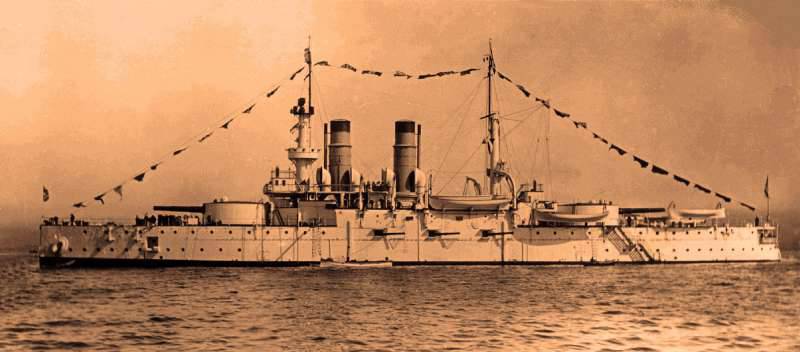
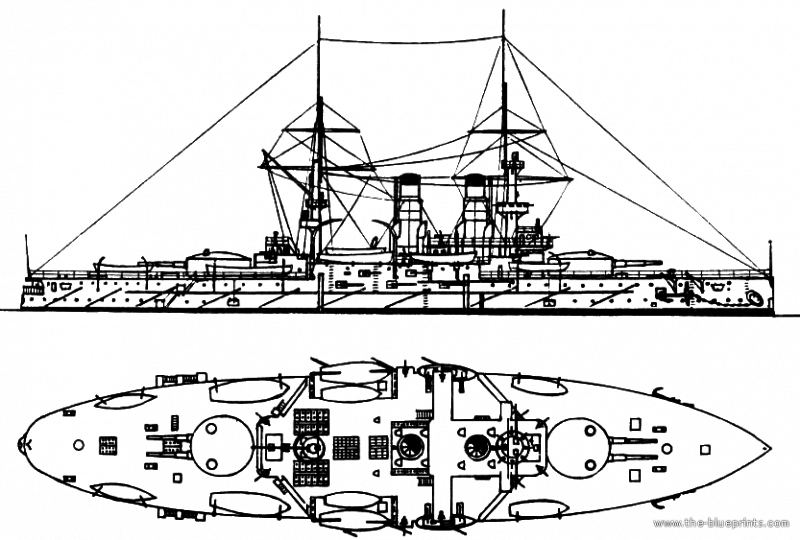
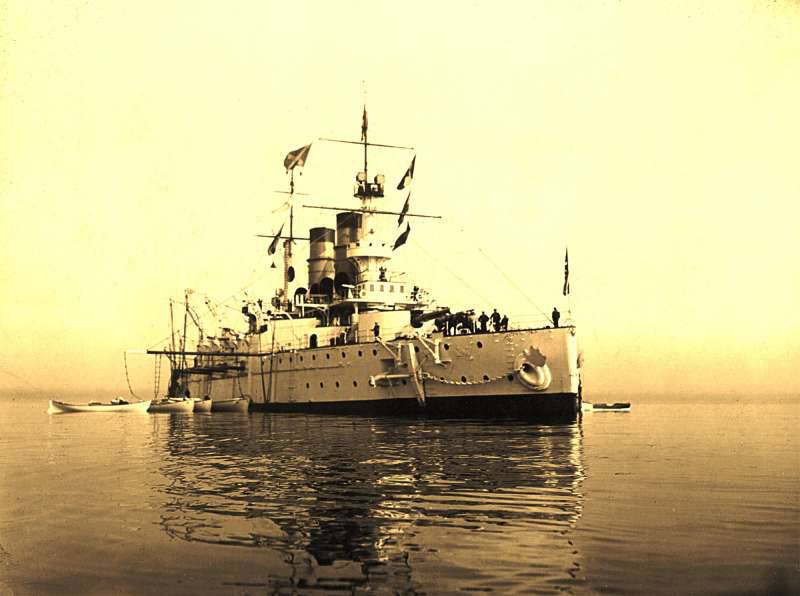
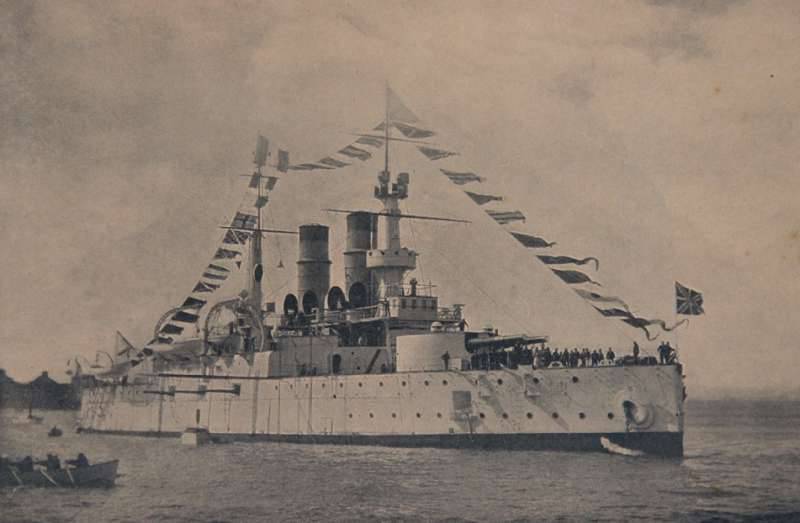
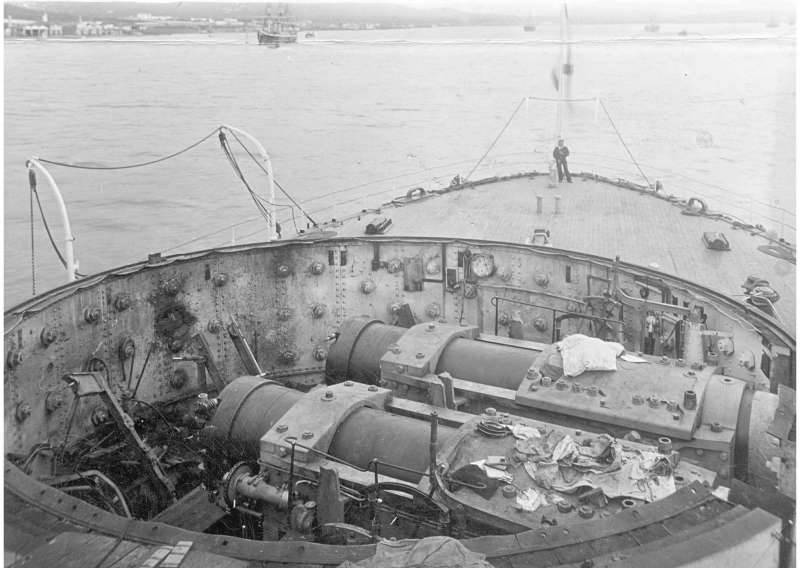
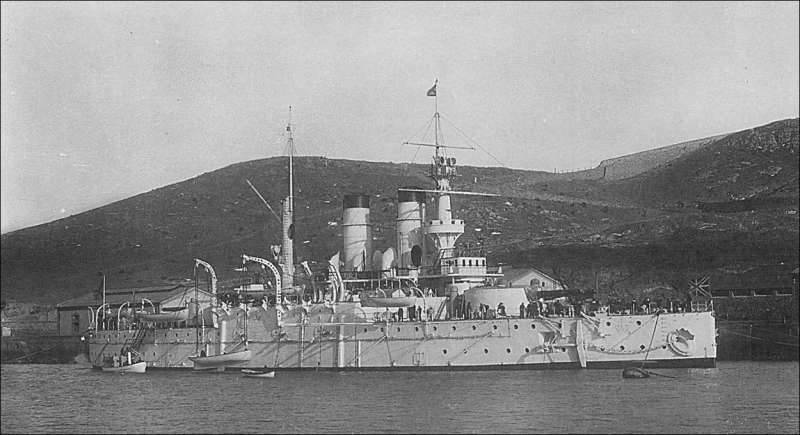
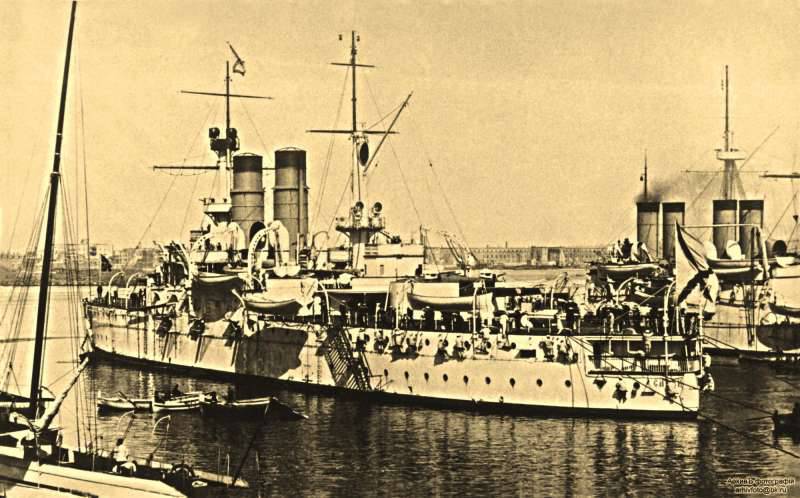
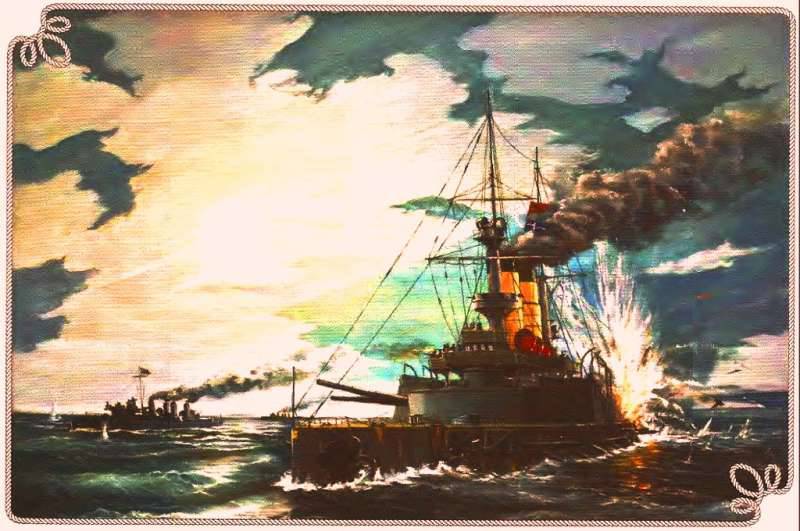
Information